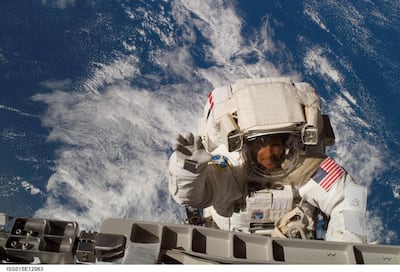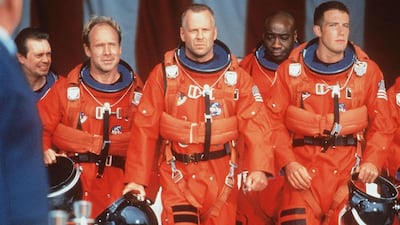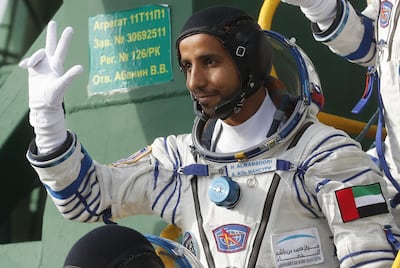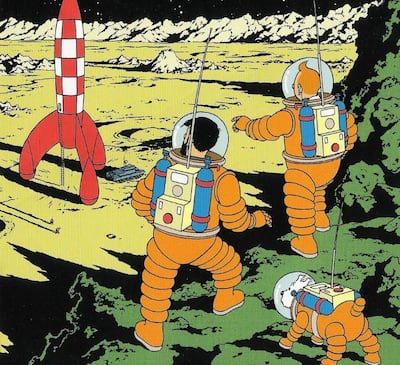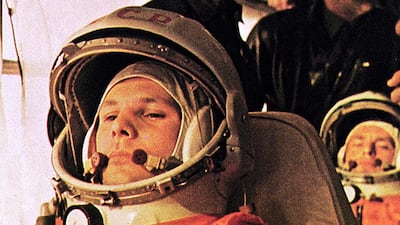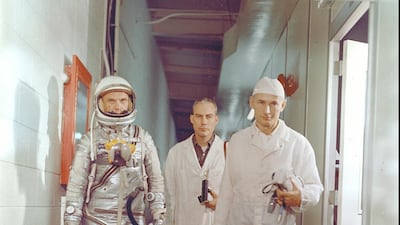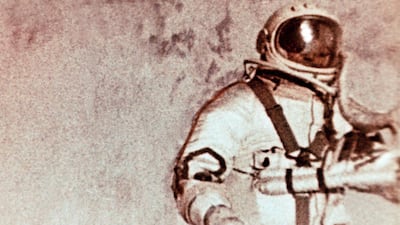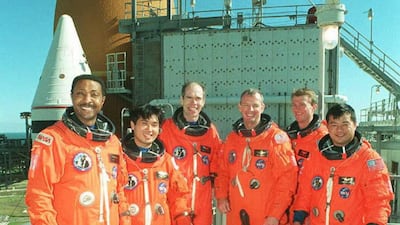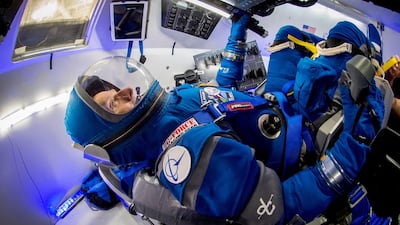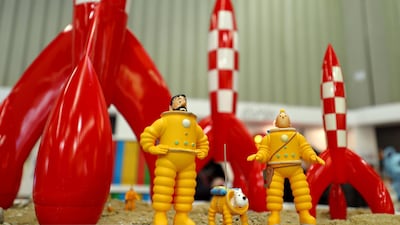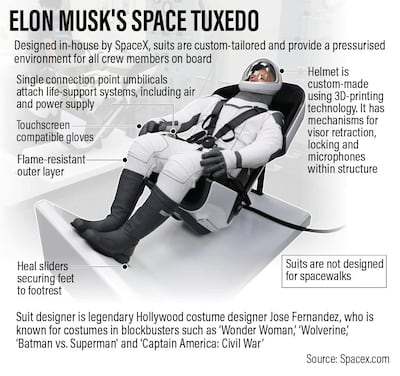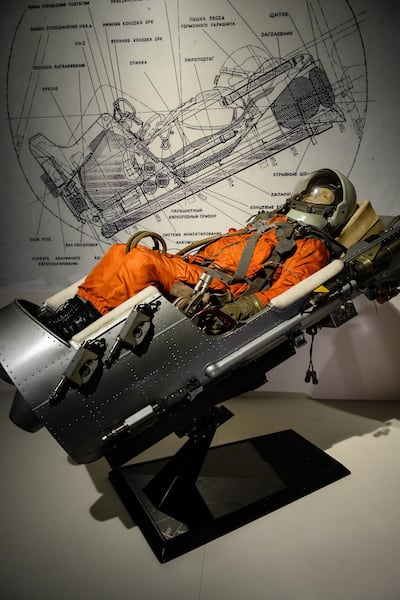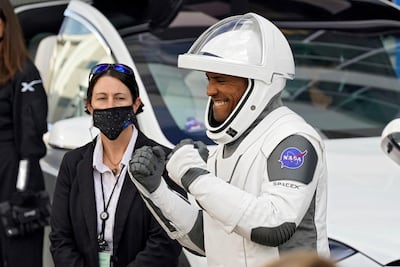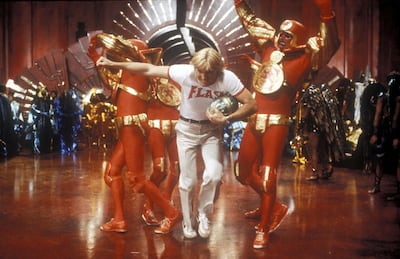What was once the race to space is now more like a fashion parade.
As seen in the first official crewed mission of the SpaceX Dragon capsule to the International Space Station, the next generation of spacesuits are the most stylish to date.
Elon Musk, the billionaire behind SpaceX, has compared their design to a night out on the town, saying “everyone looks better in a tux".
Their futuristic look, inspired by superhero characters, is a far cry from the earliest models used by the pioneers of space travel back in the 1960s.
They even rival those portrayed in science fiction, and would not look out of place on a Hollywood set.
Here we take a look at some of the most famous spacesuits of the past 60 years – and a few that exist only in science fiction.
Vostok SK-1
Worn by Russia's Yuri Gagarin on his historic first flight into orbit in 1961. The Skafandr Kosmicheskiy, or literally "suit for space" was used until 1963 and was personally designed for Gagarin. Vostok cosmonauts would eject at high altitude on their return to Earth and then parachute the final stage.
Mercury spacesuit
When John Glenn became the first American in space in February 1962, he was wearing a suit essentially based on one used by high altitude test pilots.
The MK IV full pressure suit was developed for the US Navy in 1959, while the Nasa version featured a number of improvements including removing the rubber mask that fed oxygen to the astronaut's face, and gloves with curved fingers to allow them to better grasp the controls.
Berkut spacesuit
Most spacesuits are designed to be worn during the ascent and descent stages of flight and protect the wearer in case of accidental decompression.
For spacewalks, an EVA or extra-vehicular activity suit is needed.
For the first spacewalk, in March 1965, Russia's Alexei Leonov wore an adapted version of the SK-1. It was used just once and for good reason. The suit overinflated once in space, nearly preventing Leonov from getting back into his Voskhod capsule.
A7-L series
As worn by Neil Armstrong when he became the first man to walk on the Moon in July 1969, the A7-L came in three versions, including one for flight and one for training. It was designed to resist the extremes of heat and cold on the lunar surface and its flexibility came from the help of a bra manufacturer.
Nasa turned to Playtex for the hand-stitched suits, and the brand's expertise in women's undergarments was used for the joints. A medieval suit of armour worn by King Henry VIII and displayed at the Tower of London was another design aid.
Versions of the A7-L were worn on all the Apollo and Skylab missions until 1974.
Extravehicular Mobility Unit
Introduced in 1981, this two-piece suit was designed for spacewalks of up to eight hours. For longer walks, it features what Nasa calls a Maximum Absorbency Garment – since no one can use the bathroom in space. EMUs have been on the International Space Station since 2000 and according to astronaut Doug Wheelock it "smells like a locker room."
"Pumpkin" suit
Challenger disaster in 1986, all of which retained the distinctive orange fabric, felt to stand out better against the blackness of space. It was adopted by Nasa for Space Shuttle missions after 1988.
Sokol suit
Introduced in 1973 and still worn by astronauts on the Russian Soyuz to this day. This was the suit worn by the first UAE astronaut, Hazza Al Mansouri last year. All Sokol suits are made to measure, and are designed to protect the wearer against possible decompression.
They were adopted after the deaths of three Russian astronauts in 1971 when their capsule suffered a disastrous leak on re-entry. The suits are designed to fit the seats on Soyuz, which gives their wearer a distinctive hunched look when walking.
'Boeing Blue'
Designed for the Boeing Starliner capsule, which hopes to make its first crewed flight in the new year. Along with SpaceX, Boeing has brought the private sector into space flight. Its blue flight outfit is said to be 40 per cent lighter than the old Nasa suits, and uses zips rather than clips to attach the helmet.
The must-have accessory are the blue and white boots designed by Reebok.
SpaceX Dragon suits
According to Elon Musk, he worked on the design for almost four years, saying it needed to look good as well as work well. The stylish one-piece outfit has a 3D printed helmet with a mechanical visor, built in microphones and touch sensitive gloves to work the controls.
Musk enlisted the help of Hollywood costume designer Jose Fernandez who had worked on superhero films like Batman v Superman and Fantastic Four.
"When people put this spacesuit on, he [Musk] wants them to look better than they did without it, like a tux. You look heroic in it," said Fernandez.
And a few from science fiction ...
Destination Moon
The spacesuits worn by comic book hero Tintin in Herge's 1950 Destination Moon feature the classic goldfish bowl helmet and bear a close resemblance to the Michelin Man character. They are unique in that one was designed for Tintin's dog Snowy, the first canine to go for lunar walkies.
2001: A Space Odyssey
Stanley Kubrick’s masterpiece imagined a lunar base by the turn of the century and flights provided by Pan-Am, the airline that went bust in 1991.
What he did get right was the spacesuits, which would not look out of place on a SpaceX flight. They are so realistic that conspiracy theories believe Kubrick was brought in to fake the Moon landings for Nasa.
One of the suits sold for Dh1.4 million at auction this year.
Flash Gordon
The original space hero hero, Flash Gordon has worn a variety of suits since his creation in the 1930s, including the ubiquitous goldfish bowl helmet.
For the classic film from 1980, our hero was protected by nothing more than a singlet vest and a platinum blonde helmet of hair. Among the early directors rejected for the film was one George Lucas who decided to go off and create his own homage to Flash called Star Wars. Which bring us to...
The Stormtrooper
Perhaps the coolest suit ever, as worn by the legions of bad guys in space combat for the Star Wars franchise. They may look great, but the outfits are surely the most useless ever made, causing the wearer to instantly drop dead when hit by even the weakest ray-gun shot from Han Solo.
Global state-owned investor ranking by size
|
1.
|
United States
|
|
2.
|
China
|
|
3.
|
UAE
|
|
4.
|
Japan
|
|
5
|
Norway
|
|
6.
|
Canada
|
|
7.
|
Singapore
|
|
8.
|
Australia
|
|
9.
|
Saudi Arabia
|
|
10.
|
South Korea
|
The Written World: How Literature Shaped History
Martin Puchner
Granta
Key findings of Jenkins report
- Founder of the Muslim Brotherhood, Hassan al Banna, "accepted the political utility of violence"
- Views of key Muslim Brotherhood ideologue, Sayyid Qutb, have “consistently been understood” as permitting “the use of extreme violence in the pursuit of the perfect Islamic society” and “never been institutionally disowned” by the movement.
- Muslim Brotherhood at all levels has repeatedly defended Hamas attacks against Israel, including the use of suicide bombers and the killing of civilians.
- Laying out the report in the House of Commons, David Cameron told MPs: "The main findings of the review support the conclusion that membership of, association with, or influence by the Muslim Brotherhood should be considered as a possible indicator of extremism."
12%20restaurants%20opening%20at%20the%20hotel%20this%20month
%3Cp%3EAriana%E2%80%99s%20Persian%20Kitchen%3Cbr%3EDinner%20by%20Heston%20Blumenthal%3Cbr%3EEstiatorio%20Milos%3Cbr%3EHouse%20of%20Desserts%3Cbr%3EJaleo%20by%20Jose%20Andres%3Cbr%3ELa%20Mar%3Cbr%3ELing%20Ling%3Cbr%3ELittle%20Venice%20Cake%20Company%3Cbr%3EMalibu%2090265%3Cbr%3ENobu%20by%20the%20Beach%3Cbr%3EResonance%20by%20Heston%20Blumenthal%3Cbr%3EThe%20Royal%20Tearoom%C2%A0%3C%2Fp%3E%0A
Mercer, the investment consulting arm of US services company Marsh & McLennan, expects its wealth division to at least double its assets under management (AUM) in the Middle East as wealth in the region continues to grow despite economic headwinds, a company official said.
Mercer Wealth, which globally has $160 billion in AUM, plans to boost its AUM in the region to $2-$3bn in the next 2-3 years from the present $1bn, said Yasir AbuShaban, a Dubai-based principal with Mercer Wealth.
“Within the next two to three years, we are looking at reaching $2 to $3 billion as a conservative estimate and we do see an opportunity to do so,” said Mr AbuShaban.
Mercer does not directly make investments, but allocates clients’ money they have discretion to, to professional asset managers. They also provide advice to clients.
“We have buying power. We can negotiate on their (client’s) behalf with asset managers to provide them lower fees than they otherwise would have to get on their own,” he added.
Mercer Wealth’s clients include sovereign wealth funds, family offices, and insurance companies among others.
From its office in Dubai, Mercer also looks after Africa, India and Turkey, where they also see opportunity for growth.
Wealth creation in Middle East and Africa (MEA) grew 8.5 per cent to $8.1 trillion last year from $7.5tn in 2015, higher than last year’s global average of 6 per cent and the second-highest growth in a region after Asia-Pacific which grew 9.9 per cent, according to consultancy Boston Consulting Group (BCG). In the region, where wealth grew just 1.9 per cent in 2015 compared with 2014, a pickup in oil prices has helped in wealth generation.
BCG is forecasting MEA wealth will rise to $12tn by 2021, growing at an annual average of 8 per cent.
Drivers of wealth generation in the region will be split evenly between new wealth creation and growth of performance of existing assets, according to BCG.
Another general trend in the region is clients’ looking for a comprehensive approach to investing, according to Mr AbuShaban.
“Institutional investors or some of the families are seeing a slowdown in the available capital they have to invest and in that sense they are looking at optimizing the way they manage their portfolios and making sure they are not investing haphazardly and different parts of their investment are working together,” said Mr AbuShaban.
Some clients also have a higher appetite for risk, given the low interest-rate environment that does not provide enough yield for some institutional investors. These clients are keen to invest in illiquid assets, such as private equity and infrastructure.
“What we have seen is a desire for higher returns in what has been a low-return environment specifically in various fixed income or bonds,” he said.
“In this environment, we have seen a de facto increase in the risk that clients are taking in things like illiquid investments, private equity investments, infrastructure and private debt, those kind of investments were higher illiquidity results in incrementally higher returns.”
The Abu Dhabi Investment Authority, one of the largest sovereign wealth funds, said in its 2016 report that has gradually increased its exposure in direct private equity and private credit transactions, mainly in Asian markets and especially in China and India. The authority’s private equity department focused on structured equities owing to “their defensive characteristics.”
DUNE%3A%20PART%20TWO
%3Cp%3E%3Cstrong%3EDirector%3A%3C%2Fstrong%3E%20Denis%20Villeneuve%3C%2Fp%3E%0A%3Cp%3E%3Cstrong%3EStarring%3A%3C%2Fstrong%3E%20Timothee%20Chamalet%2C%20Zendaya%2C%20Austin%20Butler%3C%2Fp%3E%0A%3Cp%3E%3Cstrong%3ERating%3A%3C%2Fstrong%3E%205%2F5%3C%2Fp%3E%0A
Teri%20Baaton%20Mein%20Aisa%20Uljha%20Jiya
%3Cp%3E%3Cstrong%3EDirectors%3A%3C%2Fstrong%3E%20Amit%20Joshi%20and%20Aradhana%20Sah%3C%2Fp%3E%0A%3Cp%3E%3Cstrong%3ECast%3A%3C%2Fstrong%3E%20Shahid%20Kapoor%2C%20Kriti%20Sanon%2C%20Dharmendra%2C%20Dimple%20Kapadia%2C%20Rakesh%20Bedi%3C%2Fp%3E%0A%3Cp%3E%3Cstrong%3ERating%3A%3C%2Fstrong%3E%204%2F5%3C%2Fp%3E%0A
Avatar: Fire and Ash
Director: James Cameron
Starring: Sam Worthington, Sigourney Weaver, Zoe Saldana
Rating: 4.5/5
Company profile
Name: Back to Games and Boardgame Space
Started: Back to Games (2015); Boardgame Space (Mark Azzam became co-founder in 2017)
Founder: Back to Games (Mr Azzam); Boardgame Space (Mr Azzam and Feras Al Bastaki)
Based: Dubai and Abu Dhabi
Industry: Back to Games (retail); Boardgame Space (wholesale and distribution)
Funding: Back to Games: self-funded by Mr Azzam with Dh1.3 million; Mr Azzam invested Dh250,000 in Boardgame Space
Growth: Back to Games: from 300 products in 2015 to 7,000 in 2019; Boardgame Space: from 34 games in 2017 to 3,500 in 2019
MATCH INFO
Uefa Champions League semi-final, first leg
Bayern Munich v Real Madrid
When: April 25, 10.45pm kick-off (UAE)
Where: Allianz Arena, Munich
Live: BeIN Sports HD
Second leg: May 1, Santiago Bernabeu, Madrid
UAE currency: the story behind the money in your pockets
COMPANY PROFILE
Founders: Alhaan Ahmed, Alyina Ahmed and Maximo Tettamanzi
Total funding: Self funded
The Lost Letters of William Woolf
Helen Cullen, Graydon House
